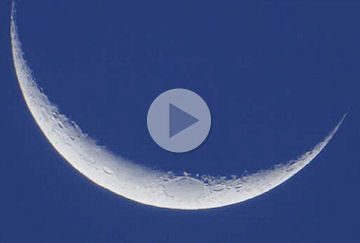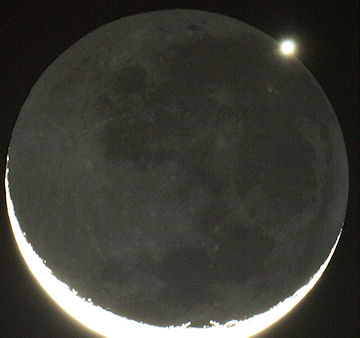NEW AND IMPROVED: Turn your iPhone or iPod Touch into a field-tested global satellite tracker. The Satellite Flybys app now works in all countries. | | | AURORA WATCH: High-latitude sky watchers should be alert for auroras on May 20th. That's when a solar wind stream is due to hit Earth, possibly sparking geomagnetic storms. [gallery] LUNAR TRANSIT: On Sunday, May 16th, space shuttle Atlantis docked to the International Space Station. Hours later, the combined spacecraft passed directly in front of the Moon over Hookset, New Hampshire. Click on the image to set the scene in motion: 
"I recorded the event using my 6-inch reflector," says photographer Tim Printy. "This was my first ISS transit and I was somewhat surprised to see how quickly the spacecraft moved across the Moon." Indeed, the entire transit lasted no more than a split second, a result of the space station's 17,000 mph orbital velocity. Watch the video again and compare the brightness of the spacecraft to that of the Moon. By itself the ISS is very bright; with Atlantis alonside, it is over the top. The combined surface brightness of the spacecraft rivals that of the Moon itself. ISS and Atlantis will be together for another 8 days. Check the Simple Satellite Tracker (or check your iPhone) for bright passes over your hometown. LUNAR OCCULTATION: Yesterday, sky watchers in parts of Africa, the Middle East, India and southeast Asia witnessed a spectacular lunar occultation of Venus. "People were awestruck and 'frozen to their feet' at the park where we watched the event," reports Armando Lee of San Miguel by the Bay, the Philippines. He took this picture using a Canon 350D at the prime focus of a 5-inch Orion telescope: 
Venus disappeared for more than 40 minutes behind the lunar disk, but the long absence wasn't the attraction. It was the transitions into and out of eclipse that really impressed onlookers. "Ingress looked like a diamond ring - Tiffany style - while egress looked like an eruption on the crescent Moon!" says Lee. more images: from Joe Chan Yuen Fai of Kennedy Town, Hong Kong; from Anthony Ayiomamitis of Athens, Greece; from Teddy Ty Chua of Manila, the Philippines; from Farmakopoulos Antonis of Mt Parnon Sparta Grecce; from Wah! of Hong Kong; from Karzaman Ahmad of Langkawi National Observatory, Malaysia; from Mark Arzadon of San Jacinto, Pangasinan, Philippines; from Liv Heather of Valenzuela City, Philippines; from Mohamad Soltanolkottabi of Niasar, Kashan, Iran; from Rana Khan of Kolkata, India;
May 2010 Aurora Gallery
[previous Mays: 2008, 2005, 2004, 2003, 2002] [aurora alerts] | 
